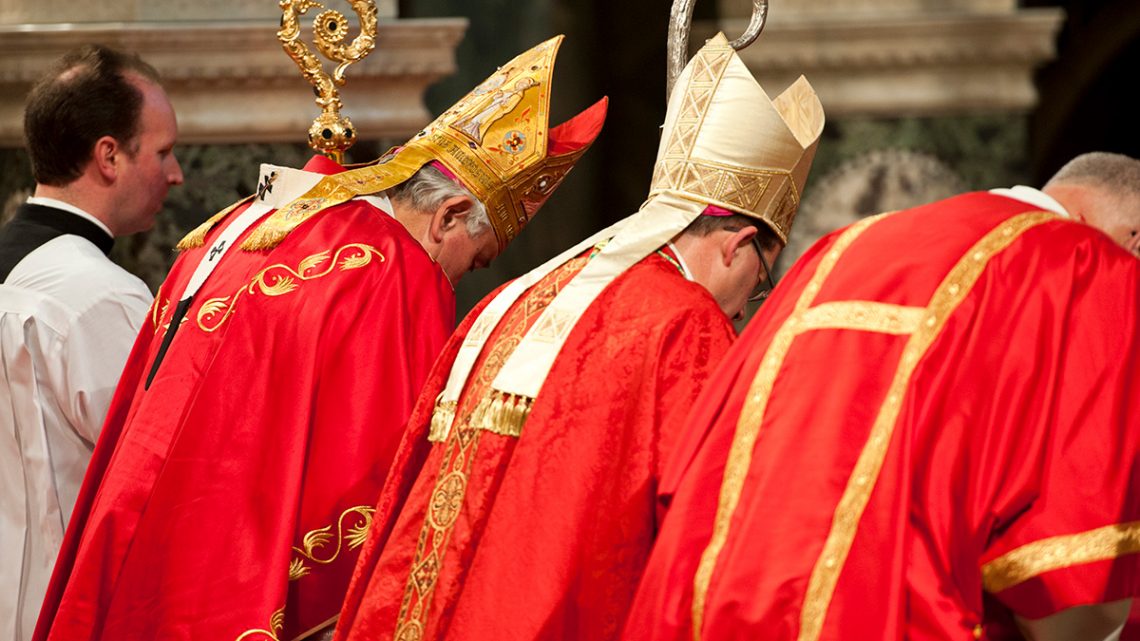A bishop heads up a local 'diocese'. Dioceses with large or important cities may have an Archbishop and assistant bishops called auxiliaries.

The Catholic Church is made up of dioceses, or geographical areas, each of which is headed by a bishop, who is the leader of that local Church. The bishop of the more important cities, or of historically important places, is given the title of Archbishop, to show a level of seniority or honour.
Jesus Christ himself appointed twelve apostles who were given the task of continuing his mission on earth; to tell everyone what he told them. He commissioned them to teach, to help others come to know God, and to receive his grace, (which is a special type of inner strength form God) through being baptised. He instructed them to lead the people, telling them that he would be with them by his Spirit at all times (Mt 28.16-20). The twelve apostles continued this mission, and others were added to their number. Chief among the apostles were St Peter, whom Jesus had called the ‘rock on which he would build the Church’ (Mt 16.18), and St Paul, a late convert who claimed the title of ‘apostle’, and was the greatest missionary of this early period. As the apostles grew older, they realised that the gifts that God had given them, and their duties, needed to be continued in the Church. Because of the graces they had been given by Jesus Christ in person, and because of his command that his Church would last until the end of time, they ‘ordained’, or commissioned, successors by laying their hands on their heads, asking God for them to be filled with the Holy Spirit.
These successors of the apostles were called ‘overseers’. From the original Greek word for ‘overseer’ (episkopos) we get the English word ‘bishop’. Ever since the beginning of the second century, every portion of the Catholic Church, or local area called a ‘diocese’, has been headed by a bishop, who has the duty to teach, sanctify (meaning, make holy) and govern God’s people. The bishop is the source of unity and sign of that unity among the people in his Diocese. He is also a link of unity with all the other bishops, and with the chief bishop, who, since the end of the first century, has been recognised as being the Bishop of Rome, the successor of Peter the Apostle. By tradition we call him the Pope, which means “father”. Among a group of Dioceses, certain ones will have been recognised, either through historical tradition, or simply because the cities are larger or more important, as having a certain seniority. The bishops of these Dioceses are called ‘Archbishops’. In England there are four Archbishops (Westminster and Southwark in London; Birmingham; and Liverpool). In Wales there is one (Cardiff). In Scotland there are two (Edinburgh and Glasgow). In England, the Archbishop of Westminster is often regarded popularly as having seniority among the other archbishops so he is always the president of the Conference of Bishops of England and Wales, the governing body of the Catholic Church in England and Wales.
The first recognisable ‘archbishop’ in England was St Augustine of Canterbury (d. 604). Legend has it that Pope Gregory the Great had seen some fair headed youths in the slave market in Rome, and when told that they were Angles, decided to send missionaries to England to convert the pagan Angle and Saxon tribes. He chose Augustine, who was a Roman Benedictine monk, and sent him to England to teach the Angles and the Saxon people living there about Jesus Christ and to establish the Church. After putting off the mission, and even turning back, Augustine arrived with his 40 companions in 597. He was given immediate permission by King Ethelbert to establish the mission in Kent, and the King himself was baptised. Augustine then established three Dioceses in Canterbury, Rochester and London. He himself became the Bishop of Canterbury. In 601, Pope Gregory made him Archbishop. Thereafter, the Archbishop of Canterbury was the ‘primate’ or senior bishop in England. With the coming of the Reformation in the sixteenth century, the Archbishop of Canterbury was subject to the authority of the reigning monarch; the Church of England having been led into schism, by Henry VIII.
“Father, by the preaching of St Augustine of Canterbury, you led the people of England to the Gospel. May the fruits of his work continue in your Church. We ask this through Jesus Christ your Son. Amen”
To see the structure of the Catholic Church’s Hierarchy go to www.catholic-hierarchy.org.
The Letter of Pope John Paul II, giving guidance for Bishops, is called Pastores Gregis, available from the Catholic Truth Society or from the Vatican VA website.
If you are in reach of Canterbury, go to the site of St Augustine’s Abbey. See the English Heritage wesbite for details.
This article was written in 2010 by a member of the catechetical team at the Maryvale Institute.